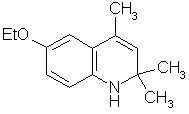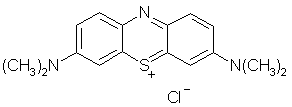
Ethoxyquin
IUPAC: 1,2-Dihydro-6-ethoxy-2,2,4-trimethylquinoline
Molecular formula: C14H19NO (MG: 217.31)
Dosage: 125 - 150 mg/kg feed
Methylene blue

Methylthionium chloride
IUPAC: 3,7-Bis(dimethylamino)phenothiazinylium chloride
C.I. 52015
Molecular formula: C16H18ClN3S (MW: 319.85)
Against Costia, Chilodonella, Trichodina, Saprolegnia, Cryptobia and Trypanosoma. Also popular for prevention and against spawn fungal infections.
The 1 % solution (10 g/l) or, if less is required, the 0.1 % solution (1 g/l) in water is used. The solution can only be kept for a long time if protected from light.
| Application and dosage | 1 % solution | 0.1 % solution |
|
Against spawn fungus |
0.3 ml / 10 litres |
3 ml / 10 litres |
|
Against infections after transport |
0.5 ml / 10 litres |
5 ml / 10 litres |
|
Normal dose (treatment in the tank) |
1.0 ml / 10 litres |
10 ml / 10 litres |
|
Increased dose (treatment in extra tank) |
3.0 ml / 10 litres |
30 ml / 10 litres |
|
Short bath |
20.0 ml / 10 litres |
200 ml / 10 litres |
Parabens

IUPAC: p-Hydroxybenzoic acid alkylester
Widely used, largely harmless preservatives. They are often used in cosmetics and pharmaceuticals as they are well tolerated and hypersensitivity reactions are rare.
|
R = |
MG |
Molecular formula |
Short name |
Trivial name |
|
-CH3 |
152,15 |
C8H8O3 |
Methylparaben |
Nipagin® |
|
-CH2CH3 |
166,17 |
C9H10O3 |
Ethylparaben |
|
|
-CH2CH2CH3 |
180,20 |
C10H12O3 |
Propylparaben |
Nipasol® |
|
-CH2CH2CH2CH3 |
194,23 |
C11H14O3 |
Butylparaben |
|
|
... |
... |
... |
... |
|
Sorbic acid or potassium sorbate
IUPAC: 2,4-Hexadienoic acid or potassium 2,4-hexadienate
Molecular formula: C6H8O2 (MG: 112.13) or C6H7KO2 (MG: 150.22)
|
|
resp. |
|
Benzoic acid
Molecular formula: C7H6O2 (MG: 122.12)




